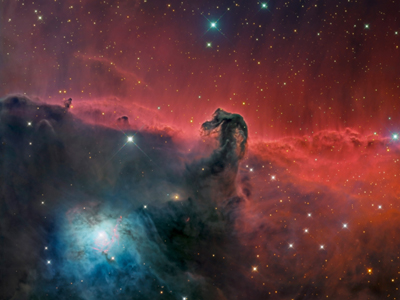|
It is very difficult to see the Horse Head by eye even when looking
through a powerful telescope Ė rather large telescope under pretty
dark sky is needed and the help of visual Hβ filter to enhance
contrast is also necessary. This is because humanís eye is quite
insensitive to the dark-red wavelength of the Hα line, on which
the background cloud mainly shines (the eye sensitivity to the bluish
Hβ color is much better and this is why humans see Horse Head
better in Hβ, despite the background nebula shines with
approximately six-times less intensity in Hβ compared to Hα
line). This is why the nebula was discovered in 1888 by Scottish
astronomer Williamina Fleming on photographs taken at the Harvard
College Observatory.

Low nebula brightness and low sensitivity of humanís eye are no
obstacles for highly sensitive CCD cameras, capable to accumulate
light for many hours, so the Horse Head was imaged countless times by
virtually every astro-photographer. But only a few of them achieve
quality rivaling images from large observatory telescopes and the
CielBoreal (http://www.cielboreal.com) and CielAustral (http://www.cielaustral.com) group of
astro-photographers definitely belongs among them. Their incredibly
detailed and exceptionally deep image of the Horse Head, acquired with
G4-16000 camera on 50cm CDK telescope at their observatory in Chile,
shows the Horse Head not as a silhouette only, but also the cloud
structure is perfectly visible. Exactly 100 hours of total exposure
time in red, green and blue filters as well as narrow-band SII,
Hα and OIII filters were necessary to create this fantastic
image.
| 